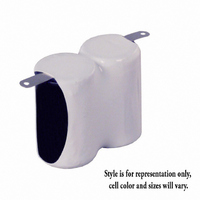P-130SCRC/FTF2 Panasonic - BSG, P-130SCRC/FTF2 Datasheet - Page 15

P-130SCRC/FTF2
Manufacturer Part Number
P-130SCRC/FTF2
Description
BATTERY PK 2.4V 1300 MAH NICAD
Manufacturer
Panasonic - BSG
Datasheet
1.P-130SCRF2.pdf
(87 pages)
Specifications of P-130SCRC/FTF2
Battery Type
Nickel Cadmium (NiCd)
Voltage - Rated
2.4V
Capacity
1300mAh
Battery Cell Size
SC - Flat Top
Number Of Cells
2
Structure
1 Row x 2 Cells Side to Side
Termination Style
Solder Tab
Rechargeability
Yes
Lead Free Status / RoHS Status
Lead free / RoHS compliant by exemption
Other names
P098-F021
CHARGE METHODS FOR NI-CD BATTERIES - CONTINUED
•
Timer-controlled Charge System
(1) Mechanism
At the start of charge, an IC timer is started (counts
up), and charge is continued at a current of 0.2 CmA
for a specified time until the timer stops. After the
timer stops, trickle charge continues at 0.05 CmA.
Fig. 3 Charge Characteristics of the Timer-controlled Charge
Fig. 4 Circuit Block Diagram of the Timer-controlled Charge
When the batteries reach the end of their cycle
life, the usage time will become markedly shorter,
and eventually two malfunction modes will occur:
an internal short-circuit and the exhaustion of the
electrolyte (the internal resistance will increase).
Therefore, when designing the charger and the
charge circuit, these malfunction modes (output
short-circuit, etc.) at the end of the cycle life must
be taken into consideration. Special care is
required regarding the rated load of the charge
current stabilizing resistance R so that an
overload does not occur at the time of these
battery malfunction modes.
System
System
V
Ich
B
to
Current
Controller
Timer
Ich
V
B
Current
Detector
NICKEL CADMIUM HANDBOOK, PAGE 14
to : Timer Starts
tc : Timer Stops
tc
t
(2) Features
•
•
General Specifications
(3) Cautions
•
•
•
- ∆ ∆ ∆ ∆ ∆ V Cut-off Charge System
(1) Mechanism
If rapid charge Ni-Cd batteries are charged at a
constant current, the battery voltage will increase as
charge progresses, peak when charge is completed,
and then subsequently decrease. Because this
voltage drop occurs regardless of the discharge level
or ambient temperature, it can be effectively used to
detect the completion of charge. The -
charge system controls charge by detecting the
voltage drop (-
N
u
m
C
Compared with the semi-constant-current charge
system (non-controlled), the addition of a charge
timer improves the long-term reliability of charge.
The construction of the charge circuit is relatively
simple and inexpensive.
This method is not appropriate for applications in
which the timer is frequently reset (charge is
restarted).
If frequent resetting of the timer is required, or if
the specific conditions of the device require that a
charge rate higher than 0.2 CmA be used (for
example, timer-controlled charge at 0.3 CmA), it
is necessary to combine this method with an
absolute temperature cut-off charge system.
The overcharge performance will vary according
to the battery type.
h
b
a
r e
A
g r
p
f o
p
e
c i l
C
L
C
C
e
h
a
h
a
v
h
b
a
l e
g r
a
e l
i r T
g r
g r
e
U
B
r e
k c
e
∆
n
C
t a
l i t
e l
i T
V) following the peak.
O
r u
e t
u
m
i T
e r
y r
p t
e
m
t n
t u
T
r e
p y
T
S
r e
e
o t
s
m
p
n i
s
a
s l
C
h
T
a
S
y
g r
FEBRUARY 2002
p
p
e
e
c i
N
C
c
0
6
l a
r u
2 .
1
∆
f i
S
h
2
e r
V cut-off
c i
C
2
o
0
G
m
u
R
t n
%
t a
s r
e
A
0
n
o i
P
0 .
r e
n
5
C
l a
s
m
A

























